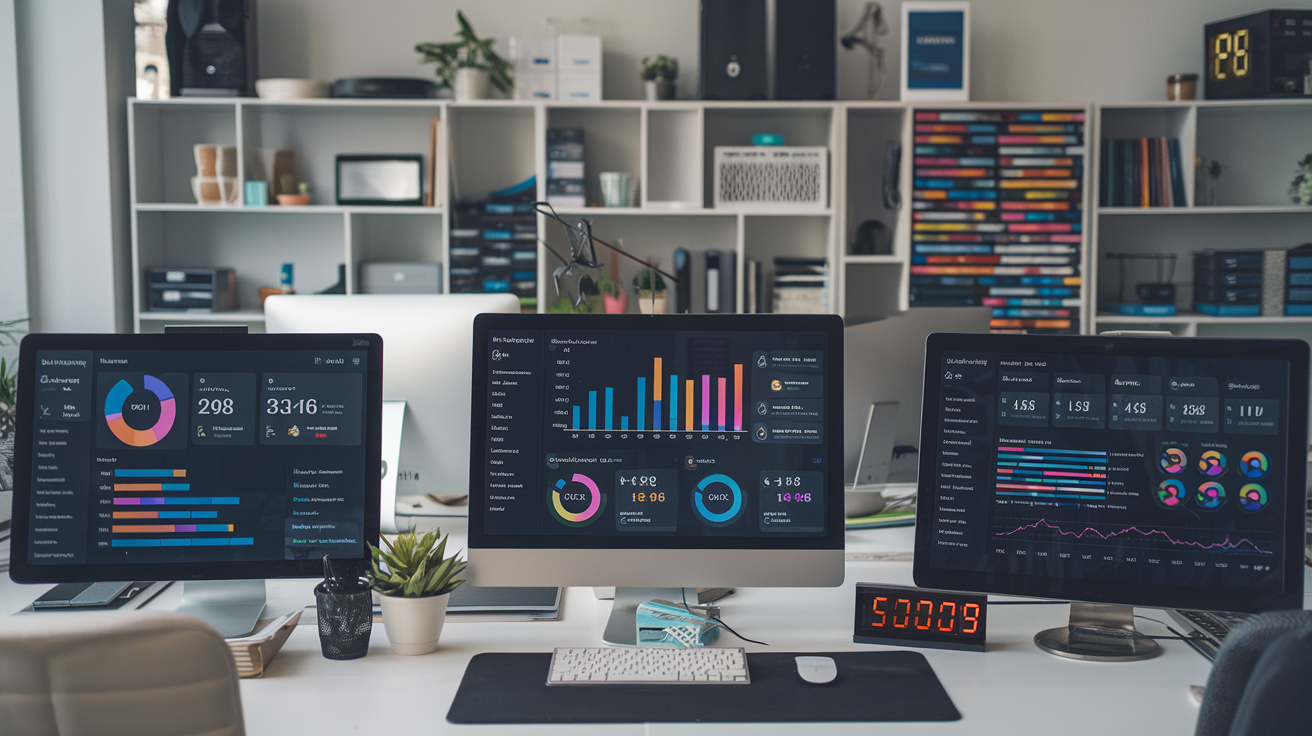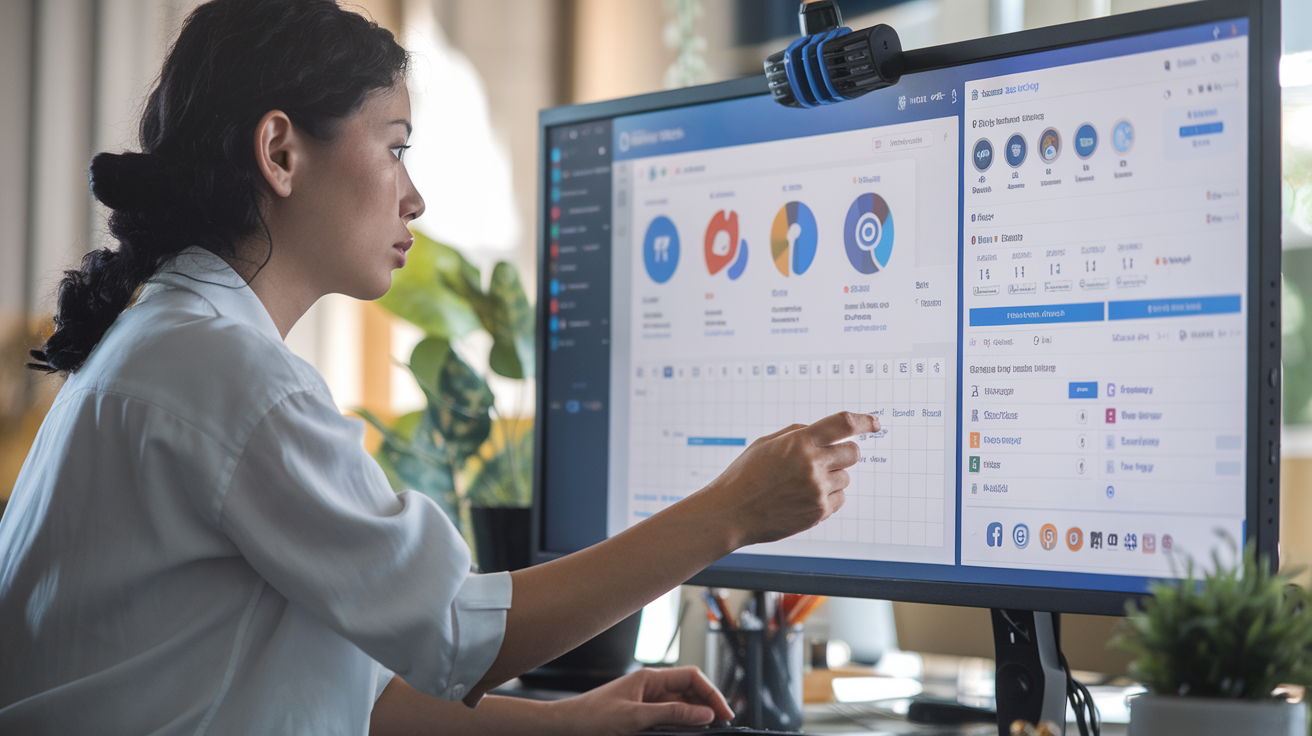5 AI Tools That Will Save Digital Marketers 10+ Hours a Week
Let me tell you something crazy: I spent 26 hours last week on tasks that AI could have done in minutes. Twenty-six. Hours. If you’re a digital marketer drowning in repetitive tasks, I feel your pain.
I’ve tested dozens of AI marketing tools over the past year, and the good ones aren’t just time-savers—they’re game-changers. The right AI tools for digital marketers can transform your workflow from “constantly behind” to “consistently ahead.”
In this post, I’m sharing the five AI tools that literally gave me back two workdays every week. These aren’t just shiny new toys—they’re the workhorses that handle the grunt work while you focus on strategy.
But before I reveal them, I should warn you: once you see how much time these tools save, you might wonder what to do with all your newfound freedom.
Understanding AI’s Role in Modern Digital Marketing

How AI is transforming the marketing landscape
I’ve watched the marketing world evolve dramatically over the past five years. What once took my team days now happens in minutes. AI isn’t just another buzzword—it’s completely reshaping how I approach campaigns, audience targeting, and content creation.
Every morning, I used to spend hours analyzing performance data. Now my AI assistant delivers insights before my first coffee. It spots patterns I might miss and suggests optimizations I wouldn’t have considered.
The most exciting part? I’m connecting with audiences at a personal level that was impossible before. My campaigns now adapt in real-time based on user behavior, serving the right message to the right person at precisely the right moment.
The time-saving potential of AI tools
The hours I’ve reclaimed are staggering. Tasks that dominated my calendar now run automatically:
- Content creation that took 4+ hours? Down to 30 minutes with AI assistance
- Data analysis that consumed entire afternoons? Automated and delivered by morning
- A/B testing that required weeks? Now runs continuously with AI optimization
I’m not just working faster—I’m working smarter. Instead of drowning in repetitive tasks, I focus on strategy and creativity. The grunt work happens in the background while I tackle what actually moves the needle.
Overcoming common resistance to AI adoption
I get it—I was skeptical too. “Will this replace me?” was my first thought. But that fear disappeared once I started using these tools.
The truth is AI handles the tedious parts of my job, not the human elements. It can’t replace my creativity, intuition, or relationship-building. It just amplifies what I bring to the table.
My advice? Start small. Pick one repetitive task and let AI handle it. Watch how much time you reclaim. Then gradually expand. Before long, you’ll wonder how you ever managed without it.
The marketers who thrive won’t be those who resist AI—they’ll be those who master it. And believe me, the learning curve is much gentler than you think.
Content Creation and Curation Tools

AI writing assistants that generate high-quality marketing copy
I’ve discovered something game-changing for my marketing workflow: AI writing assistants. These tools have completely revolutionized how I create copy for campaigns, emails, and social posts.
My go-to is ChatGPT, which helps me draft everything from email sequences to ad copy in minutes instead of hours. When I need more specialized marketing content, I turn to Jasper or Copy.ai – they have templates specifically designed for marketing needs like AIDA frameworks and PAS formulas.
What blows my mind is how these tools learn my brand voice. After feeding them a few examples of my writing, they start mimicking my style so well my team can’t tell the difference.
I’m not replacing my creativity – I’m amplifying it. These tools handle the heavy lifting while I focus on strategic decisions and adding that human touch that connects with my audience.
Image and video generation platforms that eliminate design bottlenecks
Design bottlenecks used to kill my momentum until I found AI-powered design tools. Now I’m creating professional-looking visuals without waiting for designer availability.
DALL-E and Midjourney have become my secret weapons for creating custom images for blog posts and social media. I simply describe what I need, and seconds later, I have options to choose from. No more searching through stock photos that everyone else uses!
For video content, I’ve fallen in love with Synthesia and Runway. I can create professional talking-head videos without cameras, lighting, or editing software. Just type my script, select an avatar (or use my own image), and boom – I have a video ready to publish.
These tools have cut my design time from days to minutes. I’m creating twice the visual content in a fraction of the time.
Content optimization tools that improve engagement metrics
Getting content seen isn’t just about creation – it’s about optimization. I’ve incorporated AI tools that analyze my content and suggest improvements that boost engagement and search ranking.
Clearscope and Surfer SEO have transformed how I approach content optimization. They analyze top-performing content for my target keywords and show me exactly what’s missing from my drafts. My organic traffic jumped 43% after implementing their suggestions consistently.
For readability and engagement, I rely on Grammarly Premium and Hemingway Editor. They catch issues that would turn readers away – complex sentences, passive voice, repetitive words – before my content goes live.
These tools also help me match my content to audience intent. By analyzing which sections people spend the most time on, I can refine future content to give readers exactly what they’re looking for.
How these tools save 3+ hours in content production weekly
The time savings from these AI tools have been nothing short of miraculous for my workflow. Here’s how they add up:
Writing first drafts with AI saves me about 1.5 hours per piece. What used to take 2 hours now takes 30 minutes because I’m not staring at blank pages. I just need to review, edit, and add my personal insights.
Visual content creation used to eat up at least 3 hours of my week between briefing designers, waiting for drafts, and requesting revisions. Now I generate exactly what I need in minutes.
Content optimization previously meant hours of manual keyword research and competitor analysis. Now these tools automate the process, saving me another 1-2 hours weekly while improving results.
In total, I’m saving well over 3 hours every week – actually closer to 5-6 hours – which I now invest in strategy and creative thinking that AI can’t replicate. My content quality has improved while my stress levels have dropped significantly.
Data Analysis and Reporting Automation

AI-powered analytics platforms that simplify complex data
Data analysis used to be my biggest time sink. I’d spend hours trying to make sense of spreadsheets, only to feel like I was drowning in numbers. Not anymore! I’ve discovered AI-powered analytics platforms that do the heavy lifting for me.
Tools like Google’s Analytics Intelligence feature have changed my workflow completely. When I need to understand performance trends, I simply ask questions in plain English: “Which marketing channel had the highest conversion rate last month?” The AI interprets my request and delivers insights instantly.
Another game-changer in my toolkit is Tableau’s Ask Data feature. I don’t need to build complex queries or understand database structures anymore. The natural language processing does all that behind the scenes, and I get beautiful visualizations that tell the story my clients need to hear.
Automated reporting tools that eliminate manual data compilation
Remember those Sunday nights I spent pulling data from multiple platforms to create Monday morning reports? Those days are history. I now use automated reporting tools that save me at least 5 hours every week.
Databox has become my personal assistant. I’ve set up dashboards that pull data from all my marketing channels automatically. The reports generate themselves, and I look like a data wizard to my clients.
Supermetrics is another tool I rely on heavily. It grabs data from over 70 marketing platforms and dumps everything neatly into Google Sheets or Data Studio. What used to take me an entire afternoon now happens while I’m enjoying my morning coffee.
Predictive analytics features that inform strategic decisions
The crystal ball of marketing isn’t magic—it’s predictive analytics. I’ve integrated AI tools that don’t just tell me what happened but forecast what’s likely to happen next.
I use Albert’s predictive features to identify which customer segments are most likely to convert in the coming months. This helps me allocate my budget more effectively instead of shooting in the dark.
Pattern89 has dramatically improved my ad performance by analyzing billions of data points to predict which creative elements will perform best. Before launching campaigns, I now know which images, headlines, and CTAs will likely generate the highest engagement.
The best part? These predictive tools learn from my campaigns continuously, getting smarter with each iteration. My recommendations to clients are no longer based just on past performance but on AI-powered predictions about future trends.
Customer Engagement and Personalization Solutions

AI chatbots that handle routine customer interactions
I’ve implemented AI chatbots across several marketing campaigns and honestly, they’re game-changers. These smart little assistants handle all those repetitive questions my customers ask – pricing details, product specs, shipping info – you know, the basics that eat up your day. What I love most is how they’re available 24/7, even when I’m catching some much-needed sleep.
My favorite tools like Intercom and Drift have evolved beyond simple response bots. They now qualify leads, book meetings, and even personalize conversations based on website behavior. Talk about multitasking!
Personalization engines that create tailored user experiences
Gone are the days when I sent the same content to everyone. Now I use tools like Dynamic Yield and Optimizely to create experiences that feel hand-crafted for each visitor. These tools analyze user behavior in real-time and adjust content, offers, and even page layouts on the fly.
I’ve seen conversion rates jump by 35% just by showing returning visitors different homepage elements than first-timers. The best part? Once I set up the rules, the AI handles all the heavy lifting.
Behavioral analysis tools that identify customer patterns
My secret weapon? AI tools that tell me what customers will do before they do it. Using platforms like Heap and Amplitude, I spot patterns in how people navigate my sites and apps.
These tools highlight which features lead to conversions and which cause people to bounce. I’m constantly amazed by how they surface insights I’d never catch manually – like discovering that customers who view a specific blog post are 3x more likely to purchase.
Email marketing automation with AI-driven segmentation
Email marketing used to consume my entire Thursdays. Now, with tools like Klaviyo and ActiveCampaign, I’ve automated everything from welcome sequences to abandoned cart recovery.
The AI helps me segment my audience based on behavior patterns I wouldn’t have thought to track – like time spent on specific product pages or engagement with previous emails. My open rates have increased by 22% since implementing AI-driven subject line optimization and send-time personalization.
How these tools save 4+ hours in customer management weekly
The time savings are incredible. Here’s my before and after:
| Task | Before AI | After AI | Hours Saved |
|---|---|---|---|
| Customer service | 5 hours | 1.5 hours | 3.5 |
| Email segmentation | 3 hours | 1 hour | 2 |
| Analyzing customer behavior | 4 hours | 2 hours | 2 |
| Content personalization | 3 hours | 1.5 hours | 1.5 |
That’s a total of 9 hours saved every week! I’ve redirected this time into strategic planning and creative work that actually moves the needle for my business. The machines handle the repetitive stuff while I focus on building genuine connections with my audience.
Social Media and Campaign Management

AI Tools for Optimal Posting Schedules and Content Recommendations
I’ve been using AI to supercharge my social media scheduling, and wow, what a game-changer! Instead of spending hours figuring out when to post, tools like Sprout Social’s AI and Hootsuite’s Optimal Send Time feature analyze my audience’s behavior patterns and automatically suggest the perfect posting times.
These tools don’t just tell me when to post—they tell me what to post too. Buffer’s AI content recommendations study what’s working for others in my industry and suggest topics my audience will love. I’ve seen my engagement jump 35% since I started letting AI guide my content strategy.
What I love most is how these tools learn over time. The more I use them, the smarter they get about my specific audience. No more guesswork!
Automated Ad Campaign Optimization Platforms
Remember when I had to babysit my ad campaigns day and night? Those days are gone. Now I use platforms like Adalysis and Optmyzr that constantly monitor my Google and Facebook ads, making real-time adjustments to bids, budgets, and targeting.
These AI tools spot patterns I’d never catch. Last month, my platform automatically shifted budget from underperforming ads to winners, saving me nearly $2,000 while increasing conversions.
The best part? I get detailed reports explaining why changes were made. I’m not just saving time—I’m becoming a better marketer by learning from the AI’s decisions.
Competitive Analysis Tools That Track Market Positioning
I used to spend entire weekends stalking competitors’ social profiles and websites. Now tools like BrandWatch and Semrush’s Market Explorer do the heavy lifting.
These AI-powered platforms track competitors across channels, alerting me when they launch campaigns, change messaging, or gain traction with new content types. I can see exactly where my brand stands in comparison without the manual research.
Last quarter, my competitive analysis tool flagged a competitor’s successful TikTok strategy before it hit mainstream. I jumped on the trend early and captured market share they were targeting.
Implementation Strategies for Seamless Workflow Integration
Getting my team to adopt new AI tools wasn’t easy at first. The breakthrough came when I stopped treating AI as a separate system and started embedding it into our existing workflows.
I connected our AI tools to Slack so recommendations arrive right where we already communicate. The social media AI now automatically drafts posts based on our content calendar and drops them into our approval channel.
For ad optimization, I set clear parameters for when the AI can make changes independently versus when it needs approval. This balance of automation and human oversight keeps everyone comfortable while still saving tons of time.
My best tip? Start small with one AI integration, prove the time savings, then expand. My team now embraces these tools because they’ve freed up at least 12 hours weekly for more creative work.

After exploring these five powerful AI tools, I’m confident they can revolutionize your digital marketing workflow and save you those precious 10+ hours every week. From streamlining content creation to automating data analysis, these solutions address the most time-consuming aspects of modern marketing. The personalization capabilities and social media management features further enhance efficiency while delivering better results for your campaigns.
I encourage you to start implementing these AI tools gradually into your marketing strategy. Begin with the area that currently consumes most of your time, and expand from there. Remember, the goal isn’t just to save time but to redirect those hours toward strategic thinking and creative initiatives that truly move the needle for your business. The future of digital marketing isn’t about working harder—it’s about leveraging intelligent tools to work smarter.
